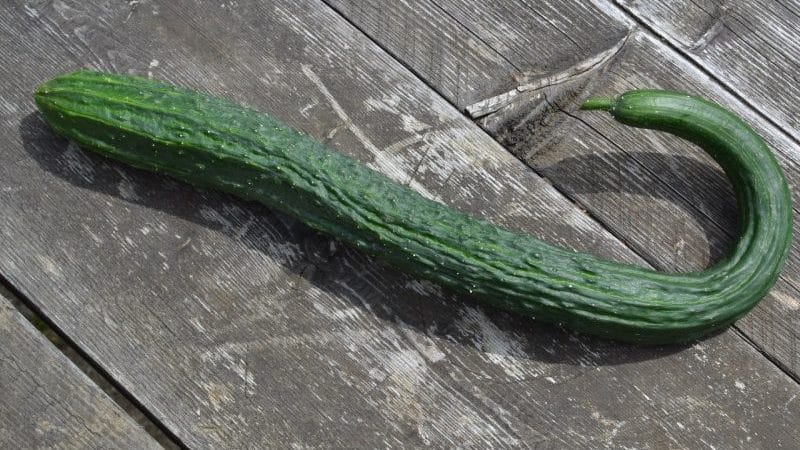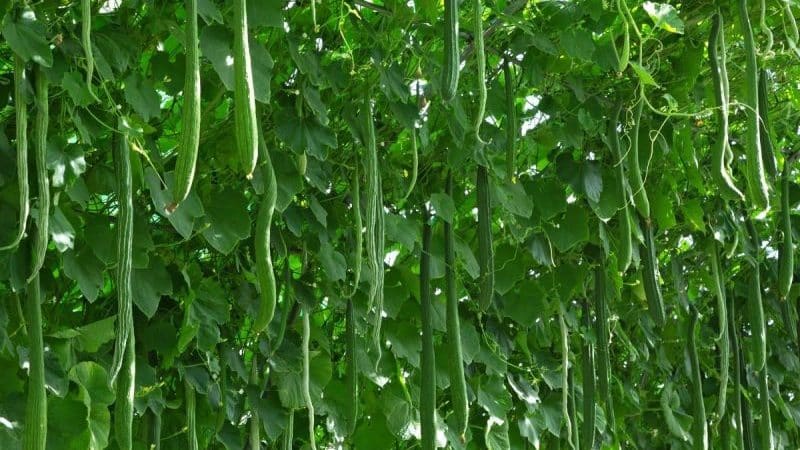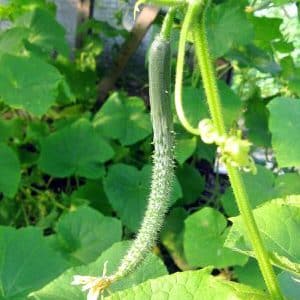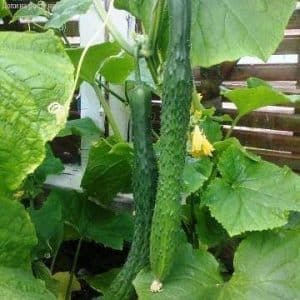How to grow long, unusually shaped “Chinese Snake” cucumbers and break yield records on your plot
Breeders annually release different varieties and hybrids of fruit plants. They are distinguished by their unusual color and shape of the crop, high yield, resistance to diseases and weather conditions. One of the interesting achievements of selection is the Chinese snake cucumber. An easy-to-care hybrid produces long, unusually shaped fruits.
Description of the hybrid
Chinese cucumbers are a separate type of crop, including several varieties. They belong to the pumpkin family, but are distinguished by unusual fruits. The Chinese snake is also included in this group.
The hybrid was recently added to the State Register of Russia - in 2015. Despite this, it has gained popularity among gardeners and former CIS countries.
Peculiarities

The main feature of the Chinese snake is its unusual fruits, which are more than 0.5 m long. They are thin, long, and curved in shape, which resembles a snake. The taste of cucumbers is specific - fresher and sweeter than that of more familiar fruits. The aroma has light watermelon notes.
Another feature of the hybrid is its tall bushes. They do not branch and take up little space.
The Chinese snake has high immunity to all diseases characteristic of the culture, and therefore does not require regular chemical treatments. The cucumber is cold-resistant and bears fruit in our country for more than 4 months.
The disadvantage of the hybrid is its low keeping quality. Already 2-3 days after the fruits are picked from the bush, they become sluggish and have a bitter taste.
This is interesting! Chinese cucumbers are also called alligator cucumbers.
Useful properties and calorie content
Snake-shaped Chinese cucumbers are dietary: per 100 g of product there are only 14 kcal, 0.8 g of protein, 0.1 fat and 2.5 g of carbohydrates.
Useful substances in fruits:
- vitamins B, K, C, A;
- choline;
- minerals: copper, sodium, potassium, chlorine, calcium, magnesium.
Thanks to this composition, the vegetable removes harmful substances and free radicals from the body, improves the functioning of the liver, kidneys and gastrointestinal tract.
This is interesting! From a biological point of view, a cucumber is a fruit.
Characteristics
Growing Chinese snake will be a pleasure even for novice gardeners.
Description of the hybrid:
| Options | Indicators |
| Bush type | Indeterminate. It reaches a height of 3–3.5 m. The leaves are ordinary, light green in color. The plant forms a few side shoots and independently forms one stem. Self-pollinating crop. Up to 2 female flowers are formed in one node. Male and female flowers are formed on the bush at the same time. |
| Fruit | Long. Each reaches 40–85 cm. The weight of one fruit is 300–400 g. Cucumbers are thin, curved, snake-like in shape. The skin is thin and tender. The color is dark green with lighter stripes at the base. The skin has large tubercles with spikes. The taste is sweet with a light watermelon aroma. There are few seeds in the fruits. |
| Productivity | High: up to 15 kg of fruits are collected from 1 m2. |
| Ripening time | Early. The first fruits are ready for harvesting 30–40 days after emergence. |
| Growing method | Recommended for greenhouse conditions. According to gardeners, it also grows in open ground. Cold resistant. |
| Transportability | Low. The fruits have thin skin, they break easily and spoil quickly. They are consumed on the first day after collection, because...after 2-3 days the vegetables become limp and bitter. |
| Disease resistance | It has high immunity to all diseases that affect the crop. |
How to grow a hybrid yourself

Chinese snake is an unpretentious hybrid of cucumbers. To grow the crop, choose beds in a semi-shaded area of the garden, because in the sun the fruits quickly turn yellow and become bitter.
Advice. It is also possible to plant the crop in a sunny area. In this case, tall plants, such as corn, are placed on both sides near the beds. This will protect the cucumbers from the scorching sun.
Cucumbers and other melons should not be planted in the same area of the garden for more than 5 years in a row. In a greenhouse where only this crop is grown, the top layer of soil is replaced. The best predecessors of the hybrid are nightshades, corn, cabbage and legumes.
The beds are prepared in the fall by digging to the depth of a spade and clearing of plant debris. 6 kg of humus or cow manure is added per 1 m2. The culture loves loose, slightly acidic soils. If the acidity is high, ash is added, and if the acidity is low, sand is added.
In spring, the beds are leveled with a rake and cleared of weeds.. The soil is mixed with 30 g of superphosphate and 25 g of ammonium nitrate per 1 m2. The soil is watered with a solution of copper sulfate prepared from 1 tbsp. l. substances and 10 liters of water.
Experienced gardeners water the beds and prepare the holes a month before planting the plants in a permanent place. At the same time, the soil is regularly cleared of weeds so that the crop takes root better.
The holes are dug 40 cm deep, in rows in a checkerboard pattern. 3-4 plants are planted per 1 m2. Place a 5 cm layer on the bottom of the holes organic fertilizers (humus or manure) and the same layer of garden soil. The earth is mixed with organic matter.The top of the hole is filled with ordinary soil.
Chinese snake produces higher yields when grown in a greenhouse. Due to its increased cold resistance, it is also suitable for open ground.
Landing
Cucumbers are grown in seedlings and without seedlings. For the Chinese kite, the second option is preferable. It has low germination rate, so not all seeds in the beds germinate.
Before sowing, planting material is prepared:
- The seeds in the package are placed near the radiator or in another warm place a month before sowing. The heated material will have greater germination.

- The grains are sorted. Dense and light specimens are left. Another way is to soak the seeds in warm water and use only those that have sunk to the bottom.
- The seeds are disinfected by soaking for half an hour in a light pink solution of potassium permanganate or for 1 hour in a mixture of 100 ml of cold water and 30 g of garlic pulp.
- Planting material is soaked in a growth stimulator. Use purchased medications (according to instructions) or homemade ones (a mixture of 1 liter of water, 1 teaspoon of nitrophoska and 1 teaspoon of ash, procedure time - 1 hour).
- The grains are placed in the refrigerator for a day to increase their cold resistance.
- The seeds are wrapped in damp cloth and kept until they hatch. All this time the fabric is kept moist. Germination usually takes 2 days.
Seed method
With this type of cultivation, the harvest is harvested later. The method is not suitable for the hybrid Chinese snake, but those who want to try it are guided by the scheme:
- wells prepared in advance are watered;
- 2 holes 4 cm deep are made in each;
- 1 seed is placed in them and sprinkled with earth;
- the beds are covered with film, which is periodically opened slightly for ventilation;
- If both seeds germinate, pinch off the weaker stem.
Seedling method
The seedling method of cultivation is suitable for the Chinese snake. The harvest is harvested earlier.
They begin to grow seedlings in May. It is planted in a permanent place after 2-3 weeks, after the formation of 3 true leaves:
- Prepare the soil for seedlings in advance. You can buy it in a store or prepare it yourself from 1 part humus, 1 part garden soil (sometimes replaced with peat) and 0.5 parts sand (sawdust). Add 1.5 tbsp to 10 kg of the resulting soil. l. nitrophoska and 2 tbsp. l. ash.

- Seeds are planted in cups 15 cm high and 25 cm in diameter. It is better to use peat containers, but plastic ones will also work.
- The soil and containers are disinfected with a dark pink solution of potassium permanganate.
- Due to poor germination, the seeds are buried 2 cm at a time, 2-3 grains at a time. After this, the soil is watered, the pots are covered with film and placed in a warm, well-lit place.
- When the seeds germinate, the plants begin to ventilate, opening the film slightly for 2–3 hours. After a week it is completely removed.
- Once a week, seedlings are watered generously. All soil in the container should become moist.
- Weaker stems are pinched, leaving one sprout in each pot.
- At the stage of formation of 2 leaves, the plants are fed with a product prepared from 2 liters of water and 2 tsp. nitrophoska.
- When the plants reach 15 cm (by the end of 3 weeks), they are transplanted into the ground. Before this, water generously.
- The crop is planted together with a lump of earth in pre-prepared holes. It is important not to damage the root system.
- Each bush is watered abundantly and 0.5 tbsp is added. ash and 25 g of nitrophoska.
Care
A high trellis is installed near each cucumber, to which the plants are attached with a synthetic thread.The first garter is done 5 days after planting in the ground.
All side shoots in the lower part of the bush (up to a height of 30 cm) are cut off. This will provide ventilation to the stem. Most gardeners remove most of the side shoots. When the cucumber becomes higher than the support, its growth is artificially limited by pinching the main stem.
Water the cucumbers daily, preferably by rain. A stream of water at room temperature is not directed at the root, but is sprayed evenly over all the bushes.
The hybrid is sensitive to fertilizing. The first one is applied 7 days after picking into open ground, the next ones - every 10 days.
The following compositions alternate:
- Dry bread is poured with warm water. When the crusts are completely swollen, the fertilizer is mixed until smooth. The bushes are watered with the product.
- Dissolve 1 tbsp in 10 liters of water. l. urea. For 1 plant use 1–2 liters of this composition.
- 1 part of fresh manure is mixed with 3 liters of warm water and left for a week. For 10 liters of water take 1 liter of the resulting product and 30 g of superphosphate.
Advice. Fertilizers are poured not under the cucumbers, but into the grooves dug between the rows.
For foliar feeding, take one of the presented fertilizers and dilute it with water in a ratio of 1:2.
Features of cultivation and possible difficulties
Knowing the nuances of growing crops will prevent many problems:
- Cucumbers become bitter if there is a lack of moisture. On hot days, they are watered 2 times a day (morning and evening).
- Stepping is carried out early in the morning in dry weather. This way the cut areas will heal faster.
- Do not wait until the fruits reach their maximum size, otherwise they will become bitter.
- If you break off part of a Chinese cucumber on a bush, the remaining part will tighten and continue to grow.
Diseases and pests
The Chinese kite is resistant to most diseases, characteristic of culture. Bushes do not require preventive treatments.
To protect against mole crickets, eggshells are buried in the holes. A soap solution will protect against small pests (rub 1 piece of soap into 1 bucket of water).
It is important to follow the rules of watering, planting and crop rotation. All working garden tools are disinfected.
Harvesting and application
Cucumber is a vegetable that is consumed only when unripe. The fruits are picked from the bush when they reach the size characteristic of the hybrid.
The fruits of the Chinese snake are harvested as early as June. They can be either straight or curved, as in the photo. Fruiting continues until the outside temperature drops below +6 °C.
After harvesting, the fruits are consumed within 24 hours. Otherwise, the taste will deteriorate and the vegetable itself will become limp.
Long Chinese snake cucumbers are ideal for eating fresh and adding to salads. They are also suitable for marinating in pieces.
Advantages and disadvantages of a hybrid
Advantages of the Chinese kite:
- earlier fruiting;
- cold resistance;
- compactness of the bush;
- ability to grow in the shade;
- excellent taste and unusual appearance of the fruit;
- ease of care;
- high productivity;
- long fruiting.
The hybrid also has disadvantages:
- impossibility of entire conservation;
- rapid loss of taste after collection;
- low transportability and short-term storage;
- the need for garter to trellises.
Reviews

Reviews from gardeners about the Chinese snake are mostly positive. The hybrid is distinguished by unusual fruits and excellent taste:
Vasilisa, Belgorod: “This is my second year growing Chinese snakes. A very unusual and tasty hybrid.Snake cucumbers are wonderful fresh, and when marinated they resemble gherkins. I feed the plants only with self-prepared fertilizers (bread and mullein).”
Ivan, Klin: “I tried to grow a Chinese snake for the first time after seeing this miracle on a neighbor’s property. The fruits are very long and thin, as in the photographs. The taste is sweet and fresh with an unusual aroma. When I want a salad, I simply break off part of a cucumber right in the garden. The remaining piece continues to grow. Very unusual, I will plant more. It is immediately necessary to clarify that other varieties are more suitable for harvesting for the winter. Although this one is tasty when preserved in pieces, it doesn’t look very nice in jars.”
Conclusion
Chinese snake cucumbers are a real exotic that takes root in the conditions of our country, as it is not afraid of cold weather and disease. The hybrid surprises with its unusual shape and taste of fruits, high yield (up to 15 kg is harvested from 1 m2) and early fruiting.
Cucumbers are suitable for personal consumption, but not for sale, since the culture has low transportability, and the taste of the vegetables quickly deteriorates after harvest.